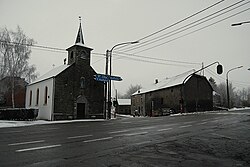
The 101st Airborne Division (Air Assault) ("Screaming Eagles") is a light infantry division of the United States Army that specializes in air assault operations. It can plan, coordinate, and execute multiple battalion-size air assault operations to seize terrain. These operations can be conducted by mobile teams covering large distances, fighting behind enemy lines, and working in austere environments with limited or degraded infrastructure. It was active in, for example, foreign internal defense and counterterrorism operations in Iraq, in Afghanistan in 2015–2016, and in Syria, as part of Operation Inherent Resolve in 2018–2021.
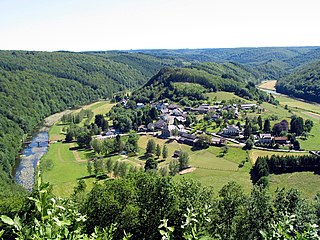
The Ardennes, also known as the Ardennes Forest or Forest of Ardennes, is a region of extensive forests, rough terrain, rolling hills and ridges primarily in Belgium and Luxembourg, extending into Germany and France.

Bastogne is a city and municipality of Wallonia located in the province of Luxembourg in the Ardennes, Belgium.

The 21st Army Group was a British headquarters formation formed during the Second World War. It controlled two field armies and other supporting units, consisting primarily of the British Second Army and the First Canadian Army. Established in London during July 1943, under the command of Supreme Headquarters Allied Expeditionary Force (SHAEF), it was assigned to Operation Overlord, the Western Allied invasion of Europe, and was an important Allied force in the European Theatre. At various times during its existence, the 21st Army Group had additional British, Canadian, American and Polish field armies or corps attached to it. The 21st Army Group operated in Northern France, Luxembourg, Belgium, the Netherlands and Germany from June 1944 until August 1945, when it was renamed the British Army of the Rhine (BAOR).

The 17th Airborne Division, "The Golden Talons", was an airborne infantry division of the United States Army during World War II, commanded by Major General William M. Miley.

The 506th Infantry Regiment, originally designated the 506th Parachute Infantry Regiment during World War II, is an airborne light infantry regiment of the United States Army. Currently a parent regiment under the U.S. Army Regimental System, the regiment has two active battalions: the 1st Battalion, 506th Infantry Regiment is assigned to the 1st Brigade Combat Team, 101st Airborne Division, and the 2nd Battalion, 506th Infantry Regiment is assigned to the 3rd Brigade Combat Team, 101st Airborne Division.

In military organizations, a pathfinder is a specialized soldier inserted or dropped into place in order to set up and operate drop zones, pickup zones, and helicopter landing sites for airborne operations, air resupply operations, or other air operations in support of the ground unit commander. Pathfinders first appeared in World War II, and continue to serve an important role in today's modern armed forces, providing commanders with the option of flexibly employing air assets. There was a group of pilots who were also designated pathfinders. They flew C-47 (DC-3) aircraft and were the lead planes followed by paratroop transports, used for dropping paratroopers into designate drop zones such as on D day, the Normandy Invasion.

The siege of Bastogne was an engagement in December 1944 between American and German forces at the Belgian town of Bastogne, as part of the larger Battle of the Bulge. The goal of the German offensive was the harbor at Antwerp. In order to reach it before the Allies could regroup and bring their superior air power to bear, German mechanized forces had to seize the roadways through eastern Belgium. Because all seven main roads in the densely wooded Ardennes highlands converged on Bastogne, just a few miles away from the border with neighboring Luxembourg, control of its crossroads was vital to the German attack.

Richard Davis Winters was a United States Army officer who served as a paratrooper in "Easy Company" of the 506th Infantry Regiment within the 101st Airborne Division during World War II. Winters was awarded the Distinguished Service Cross for his successful command of the assault on Brécourt Manor during the invasion of Normandy.

The 502nd Infantry Regiment, previously titled the 502nd Parachute Infantry Regiment, is an infantry regiment of the United States Army. The regiment was established shortly after U.S. entry into World War II, and was assigned as a regiment of the 101st Airborne Division, "The Screaming Eagles", one of the most decorated formations of the U.S. Army. The regiment saw substantial action in the European Theater of World War II and was inactivated in 1945, shortly after the end of the war. Reactivating in a new form in 1956, the 502nd Infantry has served in the Vietnam War, the Persian Gulf War, Iraq War, War in Afghanistan, and Operation Inherent Resolve in Iraq. Since 1974, the regiment has been classified as an Air Assault unit. Currently, its 1st and 2nd battalions are active. Both battalions are assigned to the 2nd Brigade Combat Team, 101st Airborne Division.
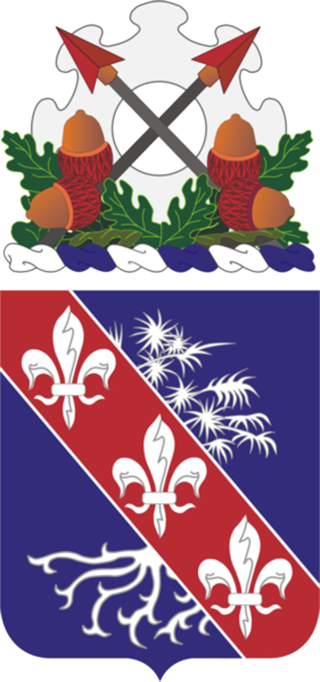
The 327th Infantry Regiment is an infantry regiment of the 101st Airborne Division of the United States Army. During World War II, the 327th was a glider-borne regiment of the 101st Airborne Division. It fought during World War I as part of the 82nd Division. It has also been deployed in the Vietnam War, Gulf War, and most recently to Iraq and Afghanistan. The song "Glider Rider" describes (humorously) some of the slights that glider-borne troops felt they received from the Army during World War II; though the regiment's public fame rose with the 1949 movie Battleground about the Siege of Bastogne in late 1944.
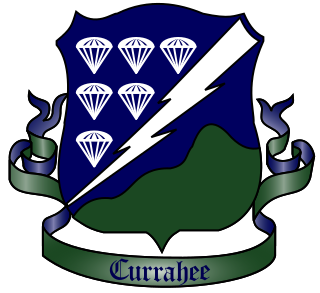
E Company, 2nd Battalion of the 506th Parachute Infantry Regiment of the 101st Airborne Division, the "Screaming Eagles", is a company in the United States Army. The company was referred to as "Easy" after the radio call for "E" in the phonetic alphabet used during World War II. The experiences of its members during that war are the subject of the 1992 book Band of Brothers by historian Stephen Ambrose and the 2001 HBO miniseries of the same name.
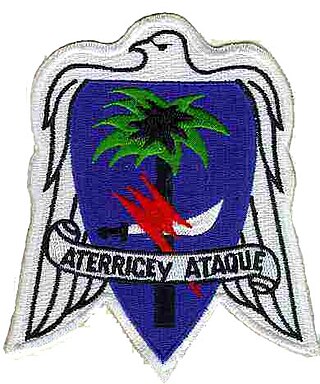
The 551st Parachute Infantry Battalion was, for many years, a little-recognized airborne forces unit of the United States Army, raised during World War II, that fought in the Battle of the Bulge. Originally commissioned to take the French Caribbean island of Martinique, they were shipped instead to Western Europe. With an initial strength of 800 officers and enlisted men, the remaining 250 members of the Battalion were ordered on 7 January 1945 to attack the Belgian village of Rochelinval over open ground and without artillery support. During the successful assault the unit lost more than half its remaining men. The Battalion was inactivated on 27 January 1945 and the remaining 110 survivors were absorbed into the 82nd Airborne Division. Virtually nothing of the unit's history was known to the American public until the 1990s when renewed interest prompted its veterans to seek recognition for their costly success at Rochelinval. The battalion was awarded a Presidential Unit Citation in 2001 recognizing its accomplishment.

The 1st Canadian Parachute Battalion was an airborne infantry battalion of the Canadian Army formed in July 1942 during the Second World War; it served in North West Europe, Landing in Normandy during Operation Tonga, in conjunction with the D-Day landings of 6 June 1944 and in the airborne assault crossing of the River Rhine, Operation Varsity, in March 1945. After the end of hostilities in Europe, the battalion was returned to Canada where it was disbanded on 30 September 1945.
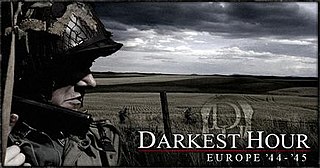
Darkest Hour: Europe '44-'45 is a free modification developed by Darklight Games, and The Darkest Hour Team for Tripwire Interactive's multiplayer first-person shooter video game Red Orchestra: Ostfront 41-45, It is based on the Western Front during World War II between 1944 and 1945, depicting the conflict between Allied and German forces. Several large-scale operations are covered, including the invasion of Normandy, Battle of the Bulge, Operation Market Garden, and Battle of the Hürtgen Forest.
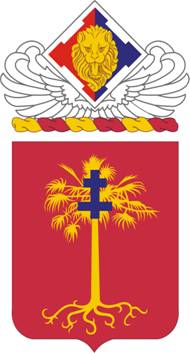
The 320th Field Artillery Regiment is a field artillery regiment of the United States Army. A parent regiment under the U.S. Army Regimental System, the 320th FAR currently has two active elements in the 101st Airborne Division : 1st Battalion, 320th FAR "Top Guns" in 2nd Brigade Combat Team; and 3rd Battalion, 320th FAR "Red Knight Rakkasans" in 3rd Brigade Combat Team. The regiment served with the 82nd Airborne Division during World Wars I and II, and regimental elements have served with the 82nd and 101st Airborne Division, the 193rd Infantry Brigade and the Berlin Brigade, and conducted combat operations in the Dominican Republic, Vietnam, Grenada, Operations Desert Shield and Storm, and the Global War on Terror.
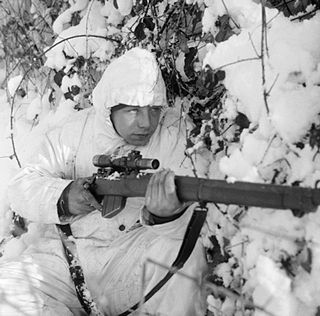
The Battle of Bure was part of the Battle of the Bulge, which lasted from 3 to 5 January 1945 during the final months of the Second World War. The battle was fought as part of the Allied counterattack to force the Germans from ground that they had captured and which had forced the Allies on the defensive. XXX Corps with British 6th Airborne Division attached, was to clear the area east of Dinant, Rochefort, Grupont and Bure in Belgium. Bure was secured after nearly three days of heavy fighting whilst Gupont and Rochefort were both cleared with little resistance and the advance continued.
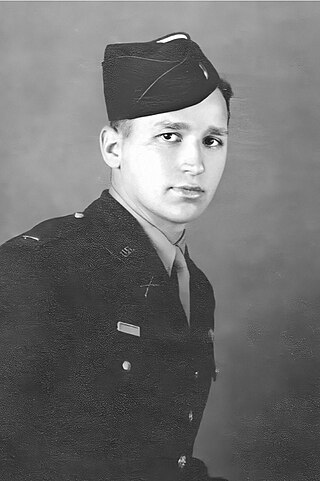
Colonel Edward David Shames was a United States Army enlisted man and officer who later served in the U.S. Army Reserve. During World War II, he was assigned to the 506th Parachute Infantry Regiment, 101st Airborne Division. Shames was Jewish and reported being deeply affected by his personal viewing of Nazi Germany's concentration camps.
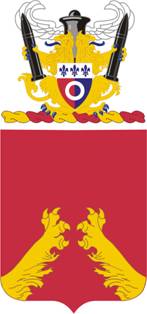
The 3rd Battalion, 321st Field Artillery Regiment is an artillery battalion, assigned to the 18th Field Artillery Brigade, part of the US Army XVIII Airborne Corps at Fort Bragg, NC. The battalion has served in World War I, World War II, and the Global War on Terror. The battalion is equipped with M142 HIMARS rocket launchers.

The 3rd Battalion, 320th Field Artillery Regiment is a Field Artillery Branch battalion assigned to the 3rd Brigade Combat Team, 101st Airborne Division. The battalion has been assigned to the 82nd Airborne Division, 11th Airborne Division and 101st Airborne Division. The battalion has participated in World War I, World War II, Operation Desert Storm, Operation Enduring Freedom, and Operation Iraqi Freedom.
